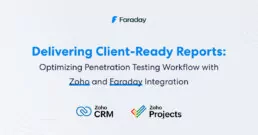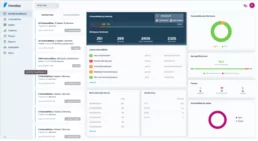Optimize reporting by integrating Faraday into Zoho.

Penetration testing is an essential process for businesses to identify vulnerabilities in their IT infrastructure and applications. To ensure a seamless and efficient workflow, integrating various tools can significantly improve the overall penetration testing service. In this blog post, we will explore how to convert a lead into a closed opportunity for a penetration test service using Zoho CRM, Zoho Projects, and Faraday. We’ll walk you through the step-by-step process, from lead generation to delivering the final report and notifying the client via email.
For the connection between platforms, we use Zapier:

Step 1: Generating and Managing Leads with Zoho CRM
To begin, you’ll need Zoho CRM to manage leads and potential clients. Start by creating a new lead and entering the relevant details, such as contact information and specific requirements for the penetration test.
Step 2: Converting Leads into Opportunities
Once you’ve engaged with the lead and determined their interest in the penetration test service, it’s time to convert them into an opportunity within Zoho CRM. This process allows you to move forward with the potential client and create a project scope.
Step 3: Creating a Zoho Project for the Penetration Test
Upon converting the lead into an opportunity and won the gig, proceed to create a new project in Zoho Projects. Include all the details for the penetration test, such as the project’s timeline, deliverables, and assigned team members.

Step 4: Listing the Targets – Websites and External IPs
As part of the project scope, it’s essential to list the targets for the test. This typically includes the websites, applications, and external IP addresses that need to be assessed for vulnerabilities.

Step 5: Setting Up Faraday Corporate Edition
Faraday Corporate Edition is a powerful penetration testing tool and risk vulnerability management that helps you conduct thorough security assessments. Install and configure Faraday to accommodate your project requirements.
Step 6: Conducting the Initial Faraday First Scan
With Faraday set up, launch the first scan on the specified targets. This will help identify potential vulnerabilities and security gaps in the selected systems.
Faraday First-Scan: It is an integrated scanner with Faraday Agents designed and tuned to discover the most common vulnerabilities in the attack surface. Faraday starts mapping your assets from your company domain name and drilling down on each to discover vulnerabilities using a tailor-made scanning profile. Once the task finishes, it is automatically pushed into your Faraday Workspace. After this, a notification will be generated; this process will run using Faraday Agents in the background.
Step 7: Analyzing the Faraday Scan Results
After the Faraday scan is complete, analyze the results carefully. Prioritize the identified vulnerabilities based on their severity and potential impact on the client’s systems.

Step 8: Generating the Faraday Report
With the vulnerabilities assessed and ranked, generate a comprehensive report using Faraday. This report should include detailed findings, suggested remediation steps, and an executive summary for non-technical stakeholders.
Step 9: Importing the Faraday Report into Zoho Projects
To keep all project-related information in one place, import the Faraday report into the Zoho Project. This will ensure that the client and the project team can access all relevant data.
Step 10: Notifying the Client via Email/Slack
Finally, it’s time to notify the client about the completed penetration test and the report’s availability. Use Zoho CRM to send a professional and informative email/slack to the client, providing them with the necessary details to access and review the report.

Integrating Zoho CRM, Zoho Projects, and Faraday into your penetration test service workflow can significantly streamline the process from lead generation to delivering the final report to the client. This well-coordinated approach enhances efficiency, communication, and client satisfaction throughout the engagement. By following the steps outlined in this blog post, you can effectively manage penetration test projects and maintain a high standard of service delivery.
Related Posts
July 17, 2024
Using Faraday API for Vulnerability Management
Within our team, we prefer to focus on specific tasks depending on the type of host and the associated vulnerabilities. Exploiting a…
April 9, 2024
Ten years of cybersecurity, a lifetime of hacking.
Faraday was born from the fusion of entrepreneurial spirit and a desire to break staffs. These elements naturally emerged in Federico…
February 15, 2024
Good practices in Cybersecurity – Part 1
Pentesters use a comprehensive and complete toolkit to expose different platforms and evaluate the security of an IT infrastructure. They…

